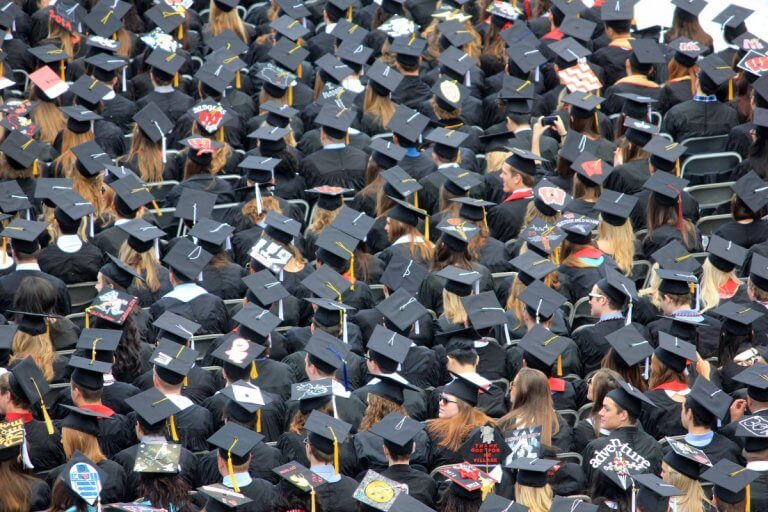
For international students, getting a degree from a US university gets more expensive by the year.
Non-native students in the US are currently paying an average of US$26,290 for undergraduate tuition and required fees at public four-year institutions, data from the National Center of Education Statistics shows. This translates to a 2.4 percent increase (USS620) before adjusting for inflation from the previous year.
When compared to the rate from almost a decade ago in 2009/10, it’s whopping 42 percent increase.
The chart below shows how the trend has been consistently going up. Each year, the fees rise by an average of 4.02 percent.
At some universities, the increase is steeper still. Between 2009 to 2012, out-of-state tuition at the University of Florida increased by at least 15 percent annually.
It provides an explanation for the media’s frequent label of international students as “cash cows” for US universities struggling with shrinking coffers.
While in-state fee increases have not been as steep, it’s not very far from the 4.02 percent increase for out-of-state student. College Board’s Trends in College Pricing 2018 report found that in-state tuition and fees at public four-year institutions increased at an average rate of 3.1 percent per year beyond inflation, just 0.92 percent less than international students.
For in-state students, this corresponds to an average annual increase of US$270 in 2018. As international student fees are usually much higher – around twice the rate – their increase in dollars would be significantly bigger too (around three times more).
This dramatic spike in fees is starting to have an impact. Gone are the days of explosive growth in foreign students. New international enrollment at US institutions has declined for the second year in a row, according to the Institute of International Education. In 2017, only 109,000 international students enrolled as first-time undergraduates, a decline of 7,000 (six percent) from the previous year.

Institutions on the coast and large research institutions are seeing growth in enrollment, findings show, but not those in the centre of the country, specifically the South Central region, which includes Texas, and the West North Central region. The less well-known schools are experiencing much sharper declines.
One takeaway from this is that foreign applicants are no longer happy to pay high prices for a US degree or have finally had enough of their declining return on investment, unless they come with the guarantee of quality or premium reputation.
While the hostile immigration policies of the Trump administration and mass shootings have dominated media headlines, IIE officials told Inside Higher Ed, there are other factors at play. Countries like Canada and Australia are offering themselves up as friendlier, more affordable alternatives. The average tuition fees for 2017 was CA$25,180 (US$19,052) per year at Canadian universities and AU$29,235 (US$21,046) at Australian universities, markedly lower than American institutions by several thousand US dollars.
Saudi Arabia’s government scholarship programs, which has sent thousands of Saudis to study at US universities, have been scrapped, resulting in a decline in the number of Saudi students at all academic levels, officials say.
Then, there’s the rising cost of US higher education as well.
“It’ll always be a very, very mixed picture, and the international education consumer is always concerned about access, diversity, quality, cost, safety, but in the past couple of years for me the biggest new development is that there are real competitor countries out there that we’ve never had before,” said Allan E Goodman, President of IIE.
Preston Cooper, a research analyst in education policy at the American Enterprise Institute wrote in Bloomberg: “Like everyone outside the Beltway, international students care more about their wallets than the president’s tweets.”

Those smiles are fading. Source: AFP/Dia Dipasupil
But other implications are on the horizon. Along with unfriendly visa and post-study work policies, we could be seeing only applicants from the highest income brackets applying to US universities. Unlike their domestic counterparts, international students have access to a significantly smaller pool of financial aid. This could spell a US higher education environment with poor diversity, perpetuating inequality further as they graduate into the market. In some second-tier institutions, major budget cuts are underway to adjust to this new reality, with professors and entire departments being laid off.
Poorer international students, repelled by the decreasing return on investment, could ditch US universities entirely, perhaps even the entire prospect of studying anywhere overseas. Instead of heading to Canada or Australia, there is growing interest in Asian research universities, particularly those in China and Singapore which have been rising, some meteorically, through global league tables. Then there’s the growth of digital learning and its considerably lower price tag, which would grow more attractive if this upward trend in fees continues.
While international students are yet to abandon the US, these trends spell trouble for its higher education sector. Unless a major shakeup is implemented soon, it could even lose its spot as the world’s most favoured study abroad destination.
Liked this? Then you’ll love…
What are your tuition fees spent on?
Blame fees, not Trump: Why international students aren’t enrolling in US universities







